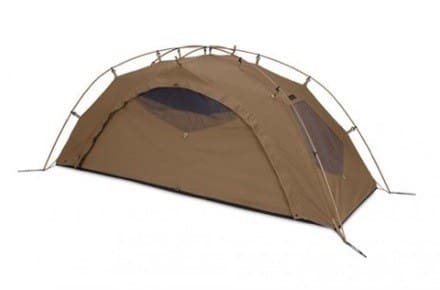Featuring a special WL Gore shelter fabric, this 1-man NEMO Shield shelter is Berry Compliant, lightweight, linkable, four-season, freestanding, waterproof, breathable, flame retardant and incorporates signature management properties.
In addition to visual opacity (blackout) and near infrared (nIR) reflection characteristics, the shelter can be used in conjunction with NEMO’s Interchangeable Camo Cover™ for adaptable visual camouflage. Available in arctic white and MultiCam®, the ICC™ is lightweight, compact, and provides a highly cost effective solution for adapting the ALCS 1P SE to different areas of operation. The ICC also serves to shade the ALCS 1P SE and protect it from UV and abrasion.
The ALCS 1P SE features a hub-based pole set for ease of set-up. For those of you unfamiliar with the concept, that means one set of poles, all connected at a central hub, making for a simple pitch of the tent. Additionally, it accepts a vestibule to increase storage or can incorporate a link that connects multiple tents.
Specifications:
Capacity: 1P
Minimum Weight: 7 lbs
Floor Dimensions: 94×35 in
Floor Area: 23 sq ft
Vestibule Area: 10.4 sq ft
Interior Height: 39 in
Doors: 2
Frame: Easton Reverse Combi
Packed Size: 20×8 in
Shell Fabric:
Gore-Tex® W/B Shelter Fabric
Vestibule Fabric:
40D PU Nylon
The NEMO Shield line is available for unit and agency orders from ADS Inc.
Tags: NEMO Shield



Nemo makes awesome gear, but 7 lbs for a one man? Yikes!! I have a 2 man Big Agnes that weighs 2.6! If they can get it down to sub 5 I would definitely buy one for hunting!
That weight is coming from the fabric. No other shelter on the market offers blackout.
It is bit heavy, but for me the most limiting factor is the price. That said, hopefully this will spawn a new design theme and we will see other tents with the connectivity feature at a reasonable price..
Wow. One shelter half, 3 poles, and 4 stakes only ways 3 lbs and is more adaptable, and dirt cheap. Weight savings haven’t forthcoming with new materials in the past 60 years, but we keep trying to reinvent the wheel anyway. If they could just use some of these fancy materials to replace the cotton duck, and wooden poles, an improved shelter half would be hard to beat.
The shelter half hasn’t been changed much since the Civil War, including size. The problem is that it requires two men to make a shelter and has no floor.
When I was stationed in LRS we had one shelter half in the unit that was passed around from guy to the next so that he had one for PLDC. And that’s as in the 80s. They suck. In fact, they suck so much that even the Marine Corps got rid of them in the 90s.
Some would say, and I do, that bivouac hasn’t changed much since the civil war. Change for change sake, that is where change isn’t a targeted improvement on older concepts, simply causes periodic dumping and redevelopment of organizational experience with doubtful value added. In this case, I don’t think the change has accompanied a shift in the way we employ bivvy shelters, i.e. in fixed camp settings, but seems to be much more expensive and heavy.
To be fair, I’m no infantryman, and your experience with LRS is probably definitive, but I did work as a trail guide before I joined, and I sleep in a shelter half whenever I backpack. I’m fairly certain most perceived short-comings with the shelter half system are mostly due to the fact that it’s not something we use regularly in the field and therefor isn’t something we train with. One half is sufficient to provide serviceable shelter for one man in an expedient situation (this is how I normally use it), which isn’t how they’re normally used in military situations, and also lighter and allows for more rapid egress than the current ICS style. I’m sure you know, but he floor is made with your poncho and liner.
The half can be set up in a variety of ways depending on your surroundings. I’ve set them up on bare rock outcroppings and slung them from trees. My set-up time is usually much faster than people with dome tents, of course frequent use probably speaks for that. The main disadvantage is that the cotton doubles in weight from 2 to 4 lbs when wet and takes a while to dry. Impregnating with wax or silicone helps a lot, but if they were just made with modern shelter materials, that wouldn’t be a problem. I don’t know the basis of issue now, but they still sell them in army clothing sales.
If you want to use it as a lean to just go with a poncho or better yet one of many commercial bashas or tarps that are made specifically for this use.
When I was a SOT-A guy in Group I usually used a poncho as a shelter along with some bungees to set it up quickly.
One of the myriad issues with the shelter half is one again that it has remained unchanged since the Civil War and is no longer now the it was then. This means that although we are now taller, it has not adapted along with us. And btw, nobody I know uses their poncho and liner to make a floor in the shelter half. But then again, I haven’t used one since PLDC in 1989.